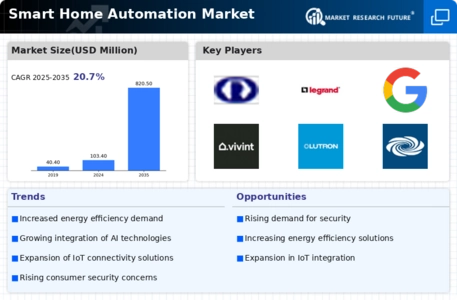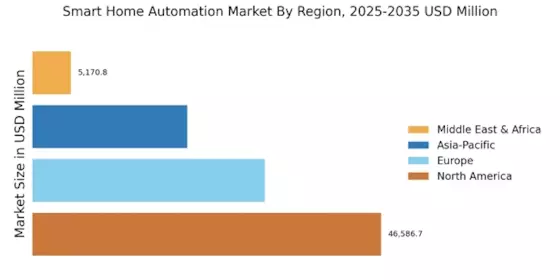The Smart Home Automation Market is currently characterized by a dynamic competitive landscape, driven by rapid technological advancements and increasing consumer demand for convenience and energy efficiency. Major players such as Amazon (US), Google (US), and Samsung (KR) are at the forefront, each adopting distinct strategies to enhance their market positioning. Amazon (US) continues to leverage its extensive ecosystem, integrating smart home devices with its voice assistant, Alexa, thereby fostering a seamless user experience. Google (US), on the other hand, emphasizes its AI capabilities, enhancing its Nest product line to offer more personalized automation solutions. Samsung (KR) focuses on interoperability, promoting its SmartThings platform to unify various smart devices, which appears to resonate well with consumers seeking cohesive smart home experiences.
The competitive structure of the Smart Home Automation Market is moderately fragmented, with numerous players vying for market share. Key tactics employed by these companies include localizing manufacturing to reduce costs and optimize supply chains, which is particularly crucial in the current economic climate. This localized approach not only enhances operational efficiency but also allows for quicker responses to market demands. The collective influence of these key players shapes a competitive environment where innovation and strategic partnerships are paramount.
In August 2025, Amazon (US) announced the launch of a new line of smart home security devices, which integrates advanced AI features for real-time threat detection. This strategic move is significant as it not only expands Amazon's product portfolio but also positions the company as a leader in the burgeoning home security segment, potentially attracting a new customer base concerned with safety and surveillance. The integration of AI into these devices may also enhance user engagement and satisfaction, further solidifying Amazon's market presence.
In September 2025, Google (US) unveiled an upgraded version of its Nest Hub, featuring enhanced voice recognition and improved smart home integration capabilities. This development underscores Google's commitment to innovation and user-centric design, suggesting that the company is keen on maintaining its competitive edge through continuous improvement of its product offerings. The focus on voice recognition technology may also indicate a broader trend towards more intuitive user interfaces in smart home devices, aligning with consumer preferences for ease of use.
In July 2025, Samsung (KR) entered into a strategic partnership with a leading energy management firm to develop smart energy solutions for residential users. This collaboration is indicative of a growing trend towards sustainability within the smart home sector, as consumers increasingly prioritize energy efficiency. By aligning with an energy management expert, Samsung (KR) not only enhances its product offerings but also positions itself as a responsible player in the market, potentially appealing to environmentally conscious consumers.
As of October 2025, the Smart Home Automation Market is witnessing trends that emphasize digitalization, sustainability, and the integration of artificial intelligence. Strategic alliances are becoming increasingly vital, as companies seek to enhance their technological capabilities and market reach. The competitive differentiation is likely to evolve from traditional price-based competition towards a focus on innovation, advanced technology, and reliable supply chains. This shift suggests that companies that prioritize these aspects will be better positioned to thrive in an increasingly competitive landscape.

















Leave a Comment